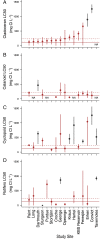Current water quality guidelines across North America and Europe do not protect lakes from salinization
- PMID: 35193976
- PMCID: PMC8892338
- DOI: 10.1073/pnas.2115033119
Current water quality guidelines across North America and Europe do not protect lakes from salinization
Abstract
Human-induced salinization caused by the use of road deicing salts, agricultural practices, mining operations, and climate change is a major threat to the biodiversity and functioning of freshwater ecosystems. Yet, it is unclear if freshwater ecosystems are protected from salinization by current water quality guidelines. Leveraging an experimental network of land-based and in-lake mesocosms across North America and Europe, we tested how salinization-indicated as elevated chloride (Cl-) concentration-will affect lake food webs and if two of the lowest Cl- thresholds found globally are sufficient to protect these food webs. Our results indicated that salinization will cause substantial zooplankton mortality at the lowest Cl- thresholds established in Canada (120 mg Cl-/L) and the United States (230 mg Cl-/L) and throughout Europe where Cl- thresholds are generally higher. For instance, at 73% of our study sites, Cl- concentrations that caused a ≥50% reduction in cladoceran abundance were at or below Cl- thresholds in Canada, in the United States, and throughout Europe. Similar trends occurred for copepod and rotifer zooplankton. The loss of zooplankton triggered a cascading effect causing an increase in phytoplankton biomass at 47% of study sites. Such changes in lake food webs could alter nutrient cycling and water clarity and trigger declines in fish production. Current Cl- thresholds across North America and Europe clearly do not adequately protect lake food webs. Water quality guidelines should be developed where they do not exist, and there is an urgent need to reassess existing guidelines to protect lake ecosystems from human-induced salinization.
Keywords: biodiversity; climate change; environmental policy; land use; water quality.
Conflict of interest statement
The authors declare no competing interest.
Figures




References
-
- Cañedo-Argüelles M., et al. , Saving freshwater from salts. Science 351, 914–916 (2016). - PubMed
-
- Dugan H. A., et al. , Lakes at risk of chloride contamination. Environ. Sci. Technol. 54, 6639–6650 (2020). - PubMed
-
- Likens G. E., Buso D. C., Salinization of Mirror Lake by road salt. Water Air Soil Pollut. 205, 205–214 (2010).

